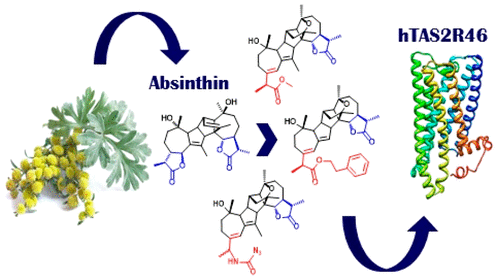当前位置:
X-MOL 学术
›
J. Nat. Prod.
›
论文详情
Our official English website, www.x-mol.net, welcomes your
feedback! (Note: you will need to create a separate account there.)
Anti-inflammatory Activity of Absinthin and Derivatives in Human Bronchoepithelial Cells.
Journal of Natural Products ( IF 3.3 ) Pub Date : 2020-06-04 , DOI: 10.1021/acs.jnatprod.9b00685 Maria Talmon 1 , Lorenza Bosso 2 , Martina Quaregna 1 , Annalisa Lopatriello 3 , Silvia Rossi 1 , Daniele Gavioli 1 , Patrizia Marotta 2 , Diego Caprioglio 2 , Renzo Boldorini 1 , Riccardo Miggiano 2 , Luigia G Fresu 1 , Federica Pollastro 2
Journal of Natural Products ( IF 3.3 ) Pub Date : 2020-06-04 , DOI: 10.1021/acs.jnatprod.9b00685 Maria Talmon 1 , Lorenza Bosso 2 , Martina Quaregna 1 , Annalisa Lopatriello 3 , Silvia Rossi 1 , Daniele Gavioli 1 , Patrizia Marotta 2 , Diego Caprioglio 2 , Renzo Boldorini 1 , Riccardo Miggiano 2 , Luigia G Fresu 1 , Federica Pollastro 2
Affiliation

|
Bitter taste receptors (hTAS2R) are expressed ectopically in various tissues, raising the possibility of a pharmacological exploitation. This seems of particular relevance in airways, since hTAS2Rs are involved in the protection of the aerial tissues from infections and in bronchodilation. The bis-guaianolide absinthin (1), one of the most bitter compounds known, targets the hTAS2R46 bitter receptor. Absinthin (1), an unstable compound, readily turns into anabsinthin (2) with substantial retention of the bitter properties, and this compound was used as a starting material to explore the chemical space around the bis-guaianolide bitter pharmacophore. Capitalizing on the chemoselective opening of the allylic lactone ring, the esters 3 and 4, and the nor-azide 6 were prepared and assayed on human bronchoepithelial (BEAS-2B) cells expressing hTAS2R46. Anti-inflammatory activity was evaluated by measuring the expression of MUC5AC, iNOS, and cytokines, as well as the production of superoxide anion, qualifying the methyl ester 3 as the best candidate for additional studies.
中文翻译:

苦艾酒及其衍生物在人支气管上皮细胞中的抗炎活性。
苦味受体 (hTAS2R) 在各种组织中异位表达,提高了药理学开发的可能性。这似乎与气道特别相关,因为 hTAS2R 参与保护气管组织免受感染和支气管扩张。bis-guaianolide absinthin ( 1 ) 是已知的最苦的化合物之一,靶向 hTAS2R46 苦味受体。Absinthin ( 1 ) 是一种不稳定的化合物,很容易转化为 anabsinthin ( 2 ),并保留了大量的苦味,该化合物被用作探索双愈创木酚内酯苦味药效团周围化学空间的起始材料。利用烯丙基内酯环的化学选择性打开,酯3和4,并且也没有叠氮化物6制备并测定对表达人hTAS2R46支气管上皮(BEAS-2B)细胞。通过测量 MUC5AC、iNOS 和细胞因子的表达以及超氧阴离子的产生来评估抗炎活性,将甲酯3定为其他研究的最佳候选者。
更新日期:2020-06-26
中文翻译:

苦艾酒及其衍生物在人支气管上皮细胞中的抗炎活性。
苦味受体 (hTAS2R) 在各种组织中异位表达,提高了药理学开发的可能性。这似乎与气道特别相关,因为 hTAS2R 参与保护气管组织免受感染和支气管扩张。bis-guaianolide absinthin ( 1 ) 是已知的最苦的化合物之一,靶向 hTAS2R46 苦味受体。Absinthin ( 1 ) 是一种不稳定的化合物,很容易转化为 anabsinthin ( 2 ),并保留了大量的苦味,该化合物被用作探索双愈创木酚内酯苦味药效团周围化学空间的起始材料。利用烯丙基内酯环的化学选择性打开,酯3和4,并且也没有叠氮化物6制备并测定对表达人hTAS2R46支气管上皮(BEAS-2B)细胞。通过测量 MUC5AC、iNOS 和细胞因子的表达以及超氧阴离子的产生来评估抗炎活性,将甲酯3定为其他研究的最佳候选者。


















































 京公网安备 11010802027423号
京公网安备 11010802027423号